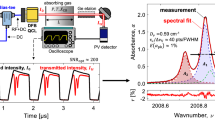Abstract
The understanding of complex phenomena, the experimental validation of calculation codes, and the construction of data bases in fluid mechanics require the development of non-intrusive experimental techniques. The laser-induced fluorescence of a gaseous molecule seeded into a gas flow can be related to the flowfield thermodynamic parameters, such as pressure and temperature. An experimental method is described, that allows the removal of the temperature dependence of the fluorescence signal. A narrow-bandwidth single-line laser is tuned to the center of an absorption line, whose temperature dependence of the Boltzmann fraction can be neglected. The experimental set-up requires a single-line dye laser and a high resolution spectral analysis device.
The accuracy of the method, checked in a static vessel, appears to be better than 5%. The method has been successfully tested with a supersonic jet issuing from an underexpanded nozzle.
The experimental results have been compared to those of an Euler calculation. A mean difference of 14% has been observed, but a major part of this can be attributed to the difference between inviscid and real gas calculation.
Similar content being viewed by others
Abbreviations
- A 21 :
-
spontaneous emission Einstein coefficient
- B v :
-
rotational energy of the J level for the v vibrational level
- B e :
-
first order approximation of B v
- c :
-
velocity of light
- C opt :
-
optical constant
- E(v) :
-
vibrational energy of the v level
- f 1 :
-
Boltzmann fraction
- FCF i :
-
Franck-Condon factor of the ith line
- f v :
-
vibrational fraction
- tf r :
-
rotational fraction
- g :
-
efficient spectral power density
- h :
-
Planck constant
- I 2 X :
-
iodine molecule in the X state
- I 2 B :
-
iodine molecule in the B state
- [I 2 X]:
-
molecular concentration of I 2 X
- [I 2 B]:
-
molecular concentration of I 2 B
- I i :
-
relative intensity of the ith absorption line
- J″:
-
rotational level of the fundamental state
- J′:
-
rotational level of the excited state
- k :
-
Boltzmann constant
- k c :
-
collisional broadening coefficient
- m :
-
iodine molecular mass
- n 0 :
-
initial concentration of iodine in the absorbing state
- P :
-
pressure
- P laser :
-
laser power
- P l(v) :
-
laser power spectral density
- P sl2 :
-
iodine vapor pressure
- Q :
-
quenching rate
- Q v :
-
vibrational partition function
- T :
-
temperature
- v″:
-
vibrational level of the fundamental state
- v′:
-
vibrational level of the excited state
- V c :
-
collection volume
- X l 2 :
-
iodine molar fraction
- λ :
-
wave length
- Δv D :
-
Doppler linewidth, at half maximum
- Δv c :
-
collisional linewidth at half maximum
- Vl :
-
laser frequency
- δ(v) :
-
Dirac function
- Δv i :
-
spectral location of a line, referenced to the laser frequency
References
Allen MG; Parker TE; Reinecke WG; Legner HH; Foutter RR; Rawlins WT; Davis SJ (1993) Fluorescence imaging of OH and NO in a model supersonic combustor. AIAA J 31: 505–512
Herzberg (1951) Spectra of diatomic molecules, Second Edition, D Van Nostrand Compagny
Hiller B; Booman RA; Hassa C; Hanson RK (1984) Velocity visualization in gas flows using laser-induced phosphorescence of blacethyl. Rev Sci Instrum 55: 1664–1669
Hiller B; Kanson RK (1988) Simultaneous planar measurements of velocity and pressure fields in gas flows using laser-induced fluorescence, Applied Optics 27: 33–48
Hiller B; Kanson RK (1990) Properties of iodine molecule relevant to laser induced fluorescence experiments in gas flows, Exp Fluids 10: 1–11
Lemoine F; Leporcq B (1993) Optical pressure measurement using laser iodine induced fluorescence, La Recherche Aérospatiale 1: 51–59
McDaniel JC (1982) Investigation of laser-induced fluorescence for the measurement of density in compressible flows, PhD Thesis Stanford University
McDaniel JC (1983a) Nonintrusive pressure measurements with laser-induced fluorescence, AIAA Paper no. 83-1468
McDaniel JC (1983b) Quantitative measurement of density and velocity in compressible flows using laser-induced iodine fluorescence, AIAA Paper no. 83-0049
McKenzie RL (1993) Progress in laser spectroscopic techniques for aerodynamic measurements: an overview, AIAA J 31: 465–477
Pascal P Nouveau traité de chimie minérale, Propriétés physiques de l'iode, Masson & cie
Paul PH; Hanson RK (1990) Applications of planar laser induced fluorescence diagnostics to reacting flows AIAA Paper no. 90-1848
Rapagnani NL; Davis SJ (1980) Flow visualisation in supersonic flows, Laser Probes for Combustion Chemistry, ACS Symposium Series, no. 134: 168–172
Rapagnani NL; Davis SJ (1985) Laser-induced fluorescence: a diagnostic for fluid Mechnics, Lasers and Applications, May issue, 127–131
Simmons JD; Hougen JT (1977) Atlas of the l 2 spectrum from 19000 to 18000 cm−1, Journal of Research of the National Bureau of Standards-A. Physics and Chemistry 81A: 25–80
Tellinghuisen J (1977) Intensity factors for the l 2 B ⇔ X band system, J Quant Spectrosc Radiat Transfer 19: 149–161
Author information
Authors and Affiliations
Rights and permissions
About this article
Cite this article
Lemoine, F., Leporcq, B. An efficient optical pressure measurement in compressible flows: Laser-induced iodine fluorescence. Experiments in Fluids 19, 150–158 (1995). https://doi.org/10.1007/BF00189703
Received:
Accepted:
Issue Date:
DOI: https://doi.org/10.1007/BF00189703




